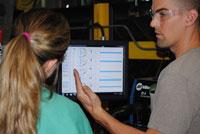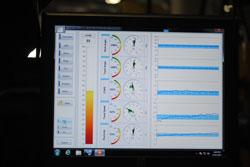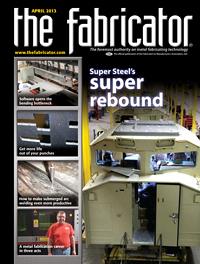Editor-in-Chief
- FMA
- The Fabricator
- FABTECH
- Canadian Metalworking
Categories
- Additive Manufacturing
- Aluminum Welding
- Arc Welding
- Assembly and Joining
- Automation and Robotics
- Bending and Forming
- Consumables
- Cutting and Weld Prep
- Electric Vehicles
- En Español
- Finishing
- Hydroforming
- Laser Cutting
- Laser Welding
- Machining
- Manufacturing Software
- Materials Handling
- Metals/Materials
- Oxyfuel Cutting
- Plasma Cutting
- Power Tools
- Punching and Other Holemaking
- Roll Forming
- Safety
- Sawing
- Shearing
- Shop Management
- Testing and Measuring
- Tube and Pipe Fabrication
- Tube and Pipe Production
- Waterjet Cutting
Industry Directory
Webcasts
Podcasts
FAB 40
Advertise
Subscribe
Account Login
Search
Welding training under the arc light
Companies, schools now have a way to give students instant feedback under real welding conditions
- By Dan Davis
- April 25, 2013
- Article
- Shop Management

Figure 1: An instructor consults with a first-time welder and discusses areas for improvement, which are charted on the monitor.
The American Welding Society (AWS) projects that the U.S. will need 238,000 welding-related professionals by 2019. Needless to say, manufacturers and trade schools have a keener interest in welding-related educational tools.
Virtual welding trainers recently appeared on the market. These devices allow would-be welders to try welding—and have their welds scored—without actually having to strike an arc. They have proven useful in showing the uninformed just what welding is about and in beginner classes.
But some organizations want something more realistic. They adhere to the belief that you’ve got to burn to learn.
About three years ago, manufacturing research organization EWI surveyed its membership and found that companies were being affected significantly by the lack of available skilled welders. These manufacturers reported that subpar welders were creating more rework and negatively affecting customer satisfaction. An EWI advisory board recognized the opportunity and encouraged the welding researchers within the organization to find a better tool for in-house training of welding talent.
The RealWeld Trainer™, using patent-pending technology developed by EWI, is the result of that work. The training device centers around a workbench with three motion-capture cameras that record travel angle, work angle, travel speed, contact tip to work, and proximity (aim in the joint) while the welder is laying down a bead with his or her own equipment. Each performance is scored and stored in a database, so the welder can practice and retest, all while charting his or her improvement.
“We want to be able to train people while they are really welding, to assess their skill level, to screen them when they come through the front door, and to do so without personal bias entering into the decision-making,” said Bill Forquer, CEO, RealWeld Systems Inc., the company charged with commercializing the training tool.
Organizations looking for this type of welding training device don’t have to do much to accommodate the equipment. The equipment has its own worktable, about the same table size that a welder normally would use to train on, and requires only a standard 110-V electrical connection. Using their own equipment, welders stand in front of the table and practice submerged arc welding, gas metal arc, or flux-cored arc welding on 6-in. coupons in one of several joint-position combinations (fillet, lap, and groove welds in the flat, horizontal, and vertical positions). The three cameras pick up all of the actions—capturing 100 frames per second.
An add-on module to the training system also keeps track of arc data parameters, current, voltage usage, and wire speed.
When the welder is done, a composite score is compiled for each of the five motions and judged against a weld procedure specification (WPS) (see Figure 1). The welder can glance at the touchscreen monitor mounted on a swivel arm attached to the worktable to check the results (see Figure 2). The effort then can be discarded or saved for future reference.
“We calibrate the work surface so we know where all the points of space are,” Forquer said. “So as you practice your stance, torch angles, and your motions associated with the welding technique for the weld, we can analyze, score that, and immediately tell you whether you stayed within the tolerance parameters—or the ‘sweet spot’—for each one of the techniques.

Figure 2: The display shows that this welder needs to be more consistent with the torch travel speed.
“We are analyzing and grading the technique, not the bead,” he added.
Each time a welder tackles a new assignment, he or she has to log in with his or her own credentials. The system tracks how far the welder has progressed according to the organization’s curriculum. If so desired, the system can demand that an instructor sign off on a segment before the welder can proceed in training.
Welding instructors can choose to use nine preconfigured, AWS-defined weld procedure specifications that come with the training equipment, or they can elect to create their own, as well as their own “sweet spot” tolerance parameters. This type of flexibility is necessary because an organization may have its own WPS that is influenced more by their own quality standards than general industry guidance.
In some instances, a company might elect to have the welding parameters match those a master welder would use. Forquer said that the motivation for that type of arrangement comes from the fact that welding instructors on different shifts may be teaching the same welding procedures, but their techniques vary somewhat from each other.
“Some companies may not have formalized training programs, but they have some master welders. These companies use some kind of mentoring process,” Forquer said. “Well, the master welder can weld on our device, and we actually can capture the master welder’s technique. Then we can configure the system to use that technique so that you are almost cloning it.”
Forquer said the primary targets for this type of training equipment are manufacturers working with heavy plate that requires high-integrity welds. Such companies include shipbuilders, crane manufacturers, mining equipment manufacturers, and structural steel fabricators.
These manufacturers also need an influx of welding talent as they come to grips with more work. Forquer said he believes this device can help these manufacturers bolster their training efforts because a majority of welding education takes place in the booth, not the classroom. Even when the welding instructor can’t offer hands-on guidance to every new welder, the trainee can consult the monitor to see just what areas need additional practice. The feedback is instantaneous.
“What we also are seeing is people applying the device in arc-off mode for beginners so they are not wasting material, coupons, and gas.They are just trying to imprint the muscle memory and getting all of that,” Forquer said.
Praxair is working with EWI to bring this live arc welding trainer to metal fabricators and welding shops in the U.S. Post-secondary technical schools also might find the training device useful as they look to expand their welding training curriculums.
About the Author

Dan Davis
2135 Point Blvd.
Elgin, IL 60123
815-227-8281
Dan Davis is editor-in-chief of The Fabricator, the industry's most widely circulated metal fabricating magazine, and its sister publications, The Tube & Pipe Journal and The Welder. He has been with the publications since April 2002.
subscribe now

The Fabricator is North America's leading magazine for the metal forming and fabricating industry. The magazine delivers the news, technical articles, and case histories that enable fabricators to do their jobs more efficiently. The Fabricator has served the industry since 1970.
start your free subscription- Stay connected from anywhere

Easily access valuable industry resources now with full access to the digital edition of The Fabricator.

Easily access valuable industry resources now with full access to the digital edition of The Welder.

Easily access valuable industry resources now with full access to the digital edition of The Tube and Pipe Journal.
- Podcasting
- Podcast:
- The Fabricator Podcast
- Published:
- 04/16/2024
- Running Time:
- 63:29
In this episode of The Fabricator Podcast, Caleb Chamberlain, co-founder and CEO of OSH Cut, discusses his company’s...
- Industry Events
16th Annual Safety Conference
- April 30 - May 1, 2024
- Elgin,
Pipe and Tube Conference
- May 21 - 22, 2024
- Omaha, NE
World-Class Roll Forming Workshop
- June 5 - 6, 2024
- Louisville, KY
Advanced Laser Application Workshop
- June 25 - 27, 2024
- Novi, MI































